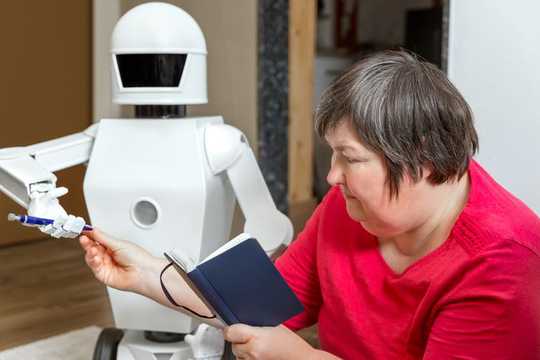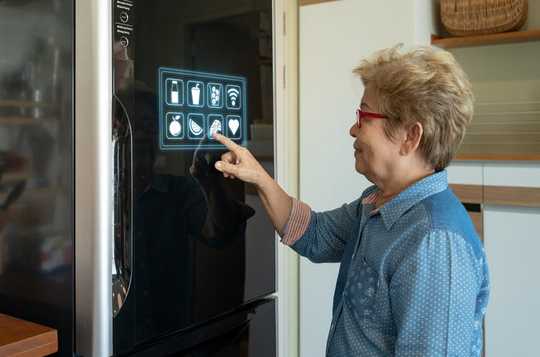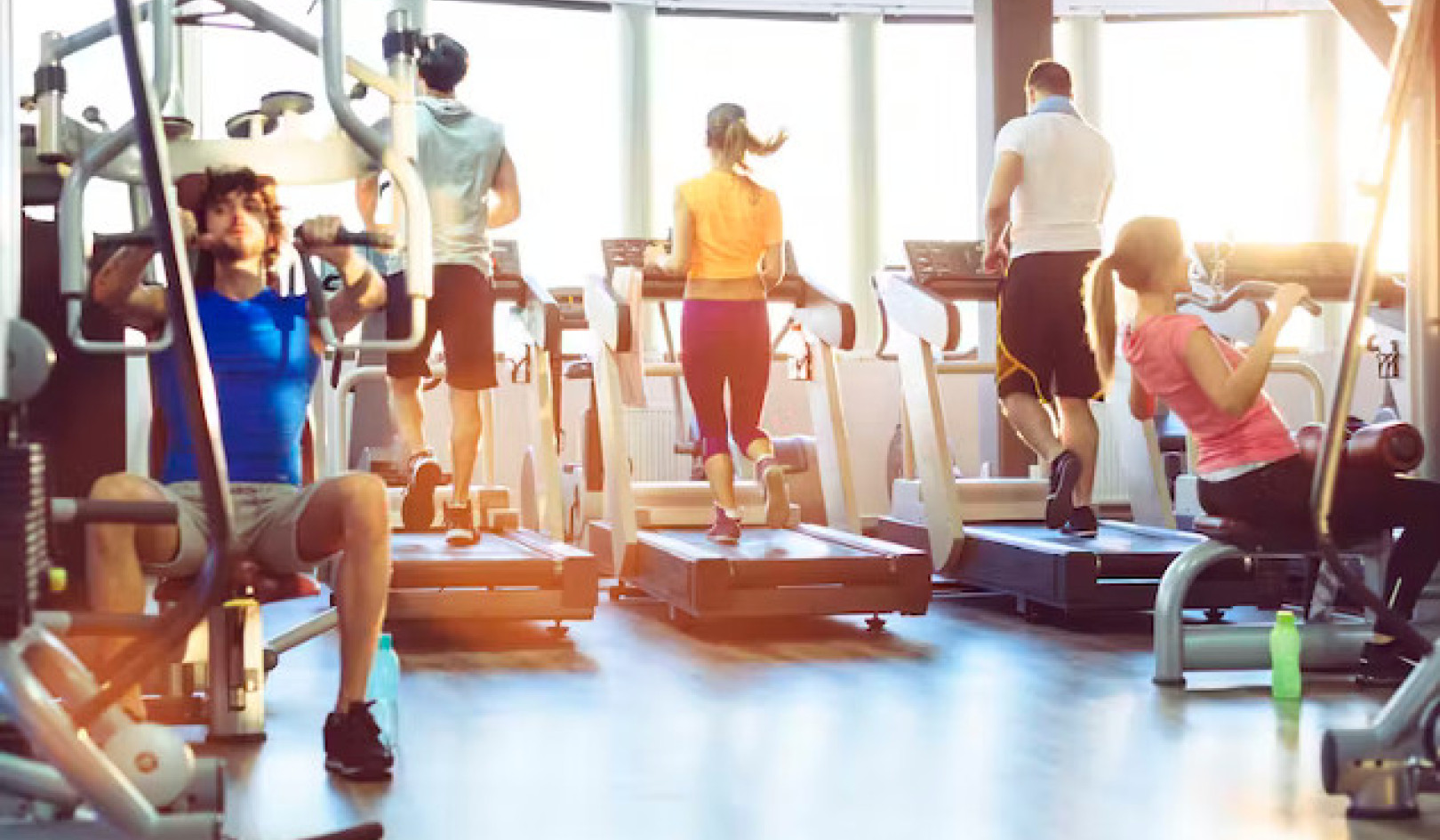You might already have what’s often called a “smart home”, with your lights or music connected to voice-controlled technology such as Alexa or Siri. But when researchers talk about smart homes, we usually mean technologies that use artificial intelligence to learn your habits and automatically adjust your home in response to them. Perhaps the most obvious example of this are thermostats that learn when you are likely to be home and what temperature you prefer, and adjust themselves accordingly without you needing to change the settings.
My colleagues and I are interested in how this kind of true smart home technology could help people with dementia. We hope it could learn to recognise the different domestic activities a dementia sufferer carries out throughout the day and help them with each one. This could even lead up to the introduction of household robots to automatically assist with chores.
The growing number of people with dementia is encouraging care providers to look to technology as a way of supporting human carers and improving patients’ quality of life. In particular, we want to use technology to help people with dementia live more independently for as long as possible.
Dementia affects people’s cognitive abilities (things like perception, learning, memory and problem-solving skills). There are many ways that smart home technology can help with this. It can improve safety by automatically closing doors if they are left open or turning off cookers if they are left unattended. Bed and chair sensors or wearable devices can detect how well someone is sleeping or if they have been inactive for an unusual amount of time.
Lights, TVs and phones can be controlled by voice-activated technology or a pictorial interface for people with memory problems. Appliances such as kettles, fridges and washing machines can be controlled remotely.
People with dementia can also become disoriented, wander and get lost. Sophisticated monitoring systems using radiowaves inside and GPS outside can track people’s movements and raise an alert if they travel outside a certain area.
All of the data from these devices could be fed in to complex artificial intelligence that would automatically learn the typical things people do in the house. This is the classic AI problem of pattern matching (looking for and learning patterns from lots of data). To start with, the computer would build a coarse model of the inhabitants’ daily routines and would then be able to detect when something unusual is happening, such as not getting up or eating at the usual time.
A finer model could then represent the steps in a particular activity such as washing hands or making a cup of tea. Monitoring what the person is doing step by step means that, if they forget halfway through, the system can remind them and help them continue.
The more general model of the daily routine could use innocuous sensors such as those in beds or doors. But for the software to have a more detailed understanding of what is happening in the house you would need cameras and video processing that would be able to detect specific actions such as someone falling over. The downside to these improved models is a loss of privacy.

Future smart homes could include robot carers. Miriam Doerr Martin Frommherz/Shutterstock
The smart home of the future could also come equipped with a humanoid robot to help with chores. Research in this area is moving at a steady, albeit slow, pace, with Japan taking the lead with nurse robots.
The biggest challenge with robots in the home or care home is that of operating in an unstructured environment. Factory robots can operate with speed and precision because they perform specific, pre-programmed tasks in a purpose-designed space. But the average home is less structured and changes frequently as furniture, objects and people move around. This is a key problem which researchers are investigating using artificial intelligence techniques, such as capturing data from images (computer vision).
Robots don’t just have the potential to help with physical labour either. While most smart home technologies focus on mobility, strength and other physical characteristics, emotional well-being is equally important. A good example is the PARO robot, which looks like a cute toy seal but is designed to provide therapeutic emotional support and comfort.
Understanding interaction
The real smartness in all this technology comes from automatically discovering how the person interacts with their environment in order to provide support at the right moment. If we just built technology to do everything for people then it would actually reduced their independence.
For example, emotion-recognition software could judge someone’s feelings from their expression could adjust the house or suggest activities in response, for example by changing the lighting or encouraging the patient to take some exercise. As the inhabitant’s physical and cognitive decline increases, the smart house would adapt to provide more appropriate support.
There are still many challenges to overcome, from improving the reliability and robustness of sensors, to preventing annoying or disturbing alarms, to making sure the technology is safe from cybercriminals. And for all the technology, there will always be a need for a human in the loop. The technology is intended to complement human carers and must be adapted to individual users. But the potential is there for genuine smart homes to help people with dementia live richer, fuller and hopefully longer lives.![]()
About the Author
Dorothy Monekosso, Professor of Computer Science, Leeds Beckett University
This article is republished from The Conversation under a Creative Commons license. Read the original article.
Video: Designing the Brain of the Home of the Future
{vembed Y=azNK_Tgkb30}

Related Books:
The New Aging: Live Smarter Now to Live Better Forever
by Dr. Eric B. Larson
This book offers practical advice for healthy aging, including tips for physical and cognitive fitness, social engagement, and finding purpose in later life.
Click for more info or to order
The Blue Zones Kitchen: 100 Recipes to Live to 100
by Dan Buettner
This cookbook offers recipes inspired by the diets of people in the world's "blue zones," where residents commonly live to 100 or older.
Click for more info or to order
Aging Backwards: Reverse the Aging Process and Look 10 Years Younger in 30 Minutes a Day
by Miranda Esmonde-White
The author offers a series of exercises and lifestyle changes to promote physical fitness and vitality in later life.
Click for more info or to order
The Longevity Paradox: How to Die Young at a Ripe Old Age
by Dr. Steven R. Gundry
This book offers advice on healthy aging, including tips for diet, exercise, and stress management, based on the latest research in longevity science.
Click for more info or to order
The Aging Brain: Proven Steps to Prevent Dementia and Sharpen Your Mind
by Timothy R. Jennings, MD
The author offers a guide for maintaining cognitive health and preventing dementia in later life, including tips for diet, exercise, and stress management.






















